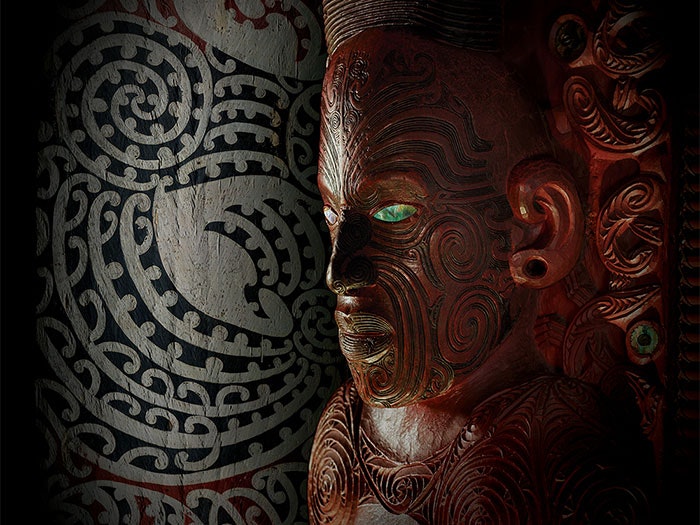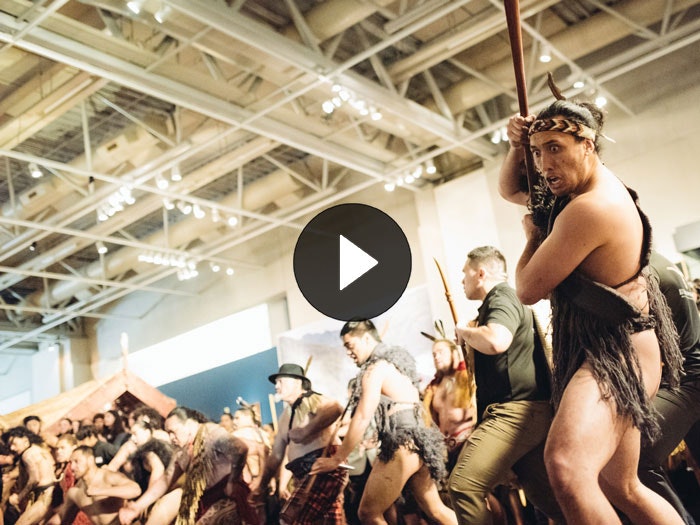Rongowhakaata welcomed as Te Papa iwi in residence
12 June 2017
Gisborne iwi Rongowhakaata was welcomed onto Rongomaraeroa marae yesterday.
Representatives of the iwi travelled from Gisborne, following a consignment of over one hundred of the taonga which will be exhibited for two and a half years in their iwi exhibition Ko Rongowhakaata: The Story of Light and Shadow at the national museum.
In the moving ceremony, Rongowhakaata iwi carried their taonga onto Rongomaraeroa marae to mark the beginning of their time as Iwi in Residence at Te Papa, in advance of their exhibition opening later in 2017.
Te Papa Kaihautū (Māori Co-leader) Dr Arapata Hakiwai says the Rongowhakaata iwi exhibition will continue the original intention of the Iwi Exhibition Programme in enabling iwi to tell their own stories and histories, and present their taonga in their own way.
“Conveying the richness of the Māori world was always an important dimension of this programme and Te Papa is honoured to have Rongowhakaata in residence sharing their taonga with the nation,” he says.
Rongowhakaata Kaumātua Lewis Moeau says “the taonga has been brought together for this exhibition in a dedicated effort by the tribe’s five marae – Manutūkē, Ōhako, Pāhou, Te Kurī, and Whakatō, each of which participated in the Rongowhakaata Marae Exhibition Rukupo in 2016.”
June 12 2017 marks 150 years since the first accession record of Rongowhakaata’s whare whakairo (carved meeting house) Te Hau ki Tūranga was entered into the records of the Colonial Museum account books. The whare was confiscated earlier that year by the Minister of Native Affairs and Acting Director of the Colonial Museum, James Crowe Richmond supported by government troops.
In 2012, as part of the Treaty of Waitangi settlement between Rongowhakaata and the Crown, the New Zealand government apologised for the forcible removal of Te Hau ki Tūranga, stating that the whare belongs to Rongowhakaata.
The Colonial Museum made extensive changes to the house in the 1920s and 1930s. Rongowhakaata is now developing a plan to restore the whare during the term of their residency at Te Papa.
Dr Hakiwai says this day marks a new horizon for Te Papa and Rongowhakaata.
“The Pōwhiri yesterday starts a new chapter where past injustices can be recognised and pathways of reconciliation and healing advanced. We look forward to working together with Rongowhakaata and actively assisting them with their cultural heritage aspirations,” he says.
“Working closely with Rongowhakaata through the Iwi in Residence programme, and in creating the exhibition, is an act of deep reflection and reconciliation for this great iwi, the museum, and Aotearoa New Zealand,” he says.
Lewis Moeau says “the relationship between Rongowhakaata and Te Papa Tongarewa is not a new relationship, but an opportunity for closer continuation of that long standing whanaungatanga (relationship, kinship) that commenced in the early 1990’s”.
The exhibition Ko Rongowhakaata: The Story of Light and Shadow focuses on the iwi’s dramatic story of innovation and adaptation and their visceral need to express their world through the spectrum of arts. The theme of light and shadow refers to the impact of light on the iwi’s environment, the East Coast landscape, and how this influences their artistry. It is also a metaphor for their story of dynamic contrasts, founded on their enduring relationships with their land and among their people.
Ko Rongowhakaata: The Story of Light and Shadow has been led by Rongowhakaata with the support of Te Papa. The exhibition stories will be told through collection item loans from institutions and families, commissioned artworks and taonga tawhito (heirlooms). The exhibition will use technology, animations and music to help bring these stories alive.
Senior Curator Mātauranga Maori, Puawai Cairns, says the exhibition has been a deeply significant project to work on.
“Te Papa is privileged to share the stories of Rongowhakaata creativity, innovation, and tenacity. This is an exceptionally taonga-rich and powerful iwi exhibition,” she says.
Notes to Editors
The iwi exhibition and iwi-in-residence programme commenced in 1998 and to date there have been seven iwi exhibitions/iwi-in-residence programmes, as follows:
Te Āti Awa (1998–1999)
Te Aupouri: People of smoke and flame (1999–2001)
Tūhoe: Moumou kai, moumou taonga, moumou tangata ki te pō (2001–2003)
Whanganui: Te Awa Tupua The Whanganui Iwi Exhibition (2003–2006)
Ngāi Tahu: Mō Tātou The Ngāi Tahu Whānui exhibition (2006–2009)
Tainui: Tai timu, tai pari, Tainui: Journey of a people (2011–2014)
Ngāti Toa: Whiti te Rā! The Story of Ngāti Toa Rangatira (2014–2017)
Ko Rongowhakaata: The Story of Light and Shadow will be the eighth iwi exhibition at Te Papa after Whiti Te Rā! The story of Ngāti Toa Rangatira closed in 2017.
Media enquiries
Ellie Campbell, Senior Communications Adviser
ellie.campbell@tepapa.govt.nz
029 601 0010

